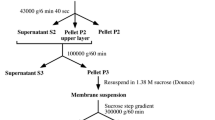Summary
An electron microscopic study of cellular modifications in mammary tissue from post-lactating mice, rats, and rabbits was undertaken. The modifications are due to resorption of previously elaborated and stored secretory material and to degeneration of a number of isolated gland cells.
Stored secretory material, in particular protein granules, are apparently digested in the cytoplasm without participation of lysosomes. Liquified homogenous material is found in the acinar lumen and in the enlarged inter-cellular spaces. It is probably carried to the still well developed capillaries of the interstitium.
The decrease of cytoplasmic volume in surviving cells and the degeneration process of dying cells involve the participation of lysosomes. The amount of ergastoplasm and Golgi elements decrease rapidly whereas free ribosomes appear. In surviving cells the autolytic process is limited to small areas of cytoplasm. Dying cells become vacuolated and are either eliminated as colostrum bodies in the acinar lumen or lysed and eliminated in the interstitium.
During this process myoepithelial cells do not undergo degeneration and play apparently an important rôle in maintaining the surviving cells together. Equally, the junctional complex ofFarquhar andPalade appears well preserved between most of the gland cells. It should be supposed that this structure is rapidly restored after elimination of dying cells.
Résumé
Des fragments de glande mammaire prélevés chez des souris, des rates et des lapines à différents stades de la régression ont été étudiés au microscope électronique.
Les modifications ultrastructurales qui accompagnent la régression traduisent soit le retour au repos soit la dégénérescence de cellules glandulaires. Les produits sécrétoires maintenus en stase sont lysés directement dans le cytoplasme sans l'intervention de lysosomes et réabsorbés à travers les espaces inter-cellulaires élargis. Au contraire, la lyse cellulaire implique la présence de lysosomes. Cette autolyse peut rester partielle et aboutir à une réduction du volume cytoplasmique, ou frapper massivement la cellule entière qui est vouée à la mort. Le matériel lysé est éliminé à travers les espaces inter-cellulaires vers les vaisseaux qui en assurent la résorption finale.
Durant ce processus, deux systèmes assurent la cohésion des cellules entre elles et la continuité de l'arbre glandulaire: les complexes de jonction et les cellules myoépithéliales qui restent logtemps préservées.
Similar content being viewed by others
Bibliographie
Bennett, H. S., andJ. H. Luft: S-collidine as a basis for buffering fixatives. J. biophys. biochem. Cytol.6, 113–114 (1959).
Duve, C. De: The lysosome concept, in Ciba Foundation Symposium on Lysosomes (A. V. S. de Reuck andM. P. Cameron, ed.). Boston: Little, Brown & Co. 1963, 1.
—: From cytases to lysosomes. Fed. Proc.23, 1045 (1964).
—, andR. Wattiaux: Functions of lysosomes. Ann. Rev. Physiol.28, 435–492 (1966).
Farquhar, M. G., andG. E. Palade: Junctional complexes in various epithelia. J. Cell Biol.17, 375–412 (1963).
Frei, J. V., andH. Sheldon: Corpus intra cristam: A dense body within mitochondria of cells in hyperplastic mouse epidermis. J. biophys. biochem. Cytol.11, 724–729 (1961).
Glauert, A. H., andR. H. Glauert: Araldite as embedding medium for electron microscopy. J. biophys. biochem. Cytol.4, 191–194 (1958).
Greenawalt, J. W., C. S. Rossi, andA. L. Lehninger: Effect of active accumulation of calcium and phosphate ions on the structure of rat liver mitochondria. J. Cell Biol.23, 21–38 (1964).
Hollmann, K. H.: Sur des aspects particuliers des protéines élaborées dans la glande mammaire. Etude au microscope électronique chez la lapine en lactation. Z. Zellforsch.69, 395–402 (1966).
Karnovsky, M. J.: Simple methods for “Staining with lead” at high pH in electron microscopy. J. biophys. biochem. Cytol.11, 729–732 (1961).
Millonig, G.: Advantages of a phosphate buffer for OsO4 solutions in fixation. J. appl. Phys.32, 16–37 (1961).
Peachey, L. D.: Electron microscopic observations on the accumulation of divalent cations in intramitochondrial granules. J. Cell Biol.20, 95–109 (1964).
Reynolds, E. S.: The use of lead citrate at high pH as an electron opaque stain for electron microscopy. J. Cell Biol.17, 208–212 (1963).
Sabatini, D. D., H. Bensch, andR. J. Barrnett: Cytochemistry and electron microscopy. The preservation of cellular ultrastructure and enzymatic activity by aldehyde fixation. J. Cell Biol.17, 19–58 (1963).
Smith, R. E., andM. G. Farquhar: Lysosome function in the regulation of the secretory process in cells of the anterior pituitary gland. J. Cell Biol.31, 319–348 (1966).
Verley, J. M., etK. H. Hollmann: Synthèse et réabsorption des protéines dans la glande mammaire en stase. Etude autoradiographique au microscope électronique. Z. Zellforsch.75, 605–610 (1966).
— —: La régression de la glande mammaire à l'arrêt de la lactation. I. Etude au microscope optique. Z. Zellforsch.82, 212–221 (1967).
Weiss, J.: Mitochondrial changes induced by potassium and sodium in the duodenal absorptive cell as studied with the electron microscope. J. exp. Med.102, 783–788 (1955).
Wellings, S. R., andK. B. Deome: Electron microscopy of milk secretion in the mammary gland of the C3H/Crgl mouse. III. Cytomorphology of the involuting gland. J. nat. Cancer Inst.30, 241–267 (1963).
Williamson, J. R.: Adipose tissue. Morphological changes associated with lipid mobilization. J. Cell Biol.20, 57–74 (1964).
Author information
Authors and Affiliations
Rights and permissions
About this article
Cite this article
Hollmann, K.H., Verley, J.M. La régression de la glande mammaire à l'arrêt de la lactation. Z.Zellforsch 82, 222–238 (1967). https://doi.org/10.1007/BF01901703
Received:
Issue Date:
DOI: https://doi.org/10.1007/BF01901703




